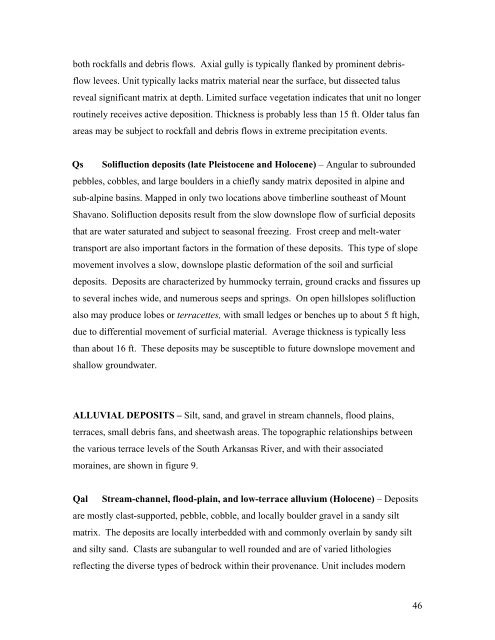Geologic Map of the Maysville Quadrangle, Chaffee County, Colorado
Geologic Map of the Maysville Quadrangle, Chaffee County, Colorado
Geologic Map of the Maysville Quadrangle, Chaffee County, Colorado
You also want an ePaper? Increase the reach of your titles
YUMPU automatically turns print PDFs into web optimized ePapers that Google loves.
oth rockfalls and debris flows. Axial gully is typically flanked by prominent debrisflow<br />
levees. Unit typically lacks matrix material near <strong>the</strong> surface, but dissected talus<br />
reveal significant matrix at depth. Limited surface vegetation indicates that unit no longer<br />
routinely receives active deposition. Thickness is probably less than 15 ft. Older talus fan<br />
areas may be subject to rockfall and debris flows in extreme precipitation events.<br />
Qs Solifluction deposits (late Pleistocene and Holocene) – Angular to subrounded<br />
pebbles, cobbles, and large boulders in a chiefly sandy matrix deposited in alpine and<br />
sub-alpine basins. <strong>Map</strong>ped in only two locations above timberline sou<strong>the</strong>ast <strong>of</strong> Mount<br />
Shavano. Solifluction deposits result from <strong>the</strong> slow downslope flow <strong>of</strong> surficial deposits<br />
that are water saturated and subject to seasonal freezing. Frost creep and melt-water<br />
transport are also important factors in <strong>the</strong> formation <strong>of</strong> <strong>the</strong>se deposits. This type <strong>of</strong> slope<br />
movement involves a slow, downslope plastic deformation <strong>of</strong> <strong>the</strong> soil and surficial<br />
deposits. Deposits are characterized by hummocky terrain, ground cracks and fissures up<br />
to several inches wide, and numerous seeps and springs. On open hillslopes solifluction<br />
also may produce lobes or terracettes, with small ledges or benches up to about 5 ft high,<br />
due to differential movement <strong>of</strong> surficial material. Average thickness is typically less<br />
than about 16 ft. These deposits may be susceptible to future downslope movement and<br />
shallow groundwater.<br />
ALLUVIAL DEPOSITS – Silt, sand, and gravel in stream channels, flood plains,<br />
terraces, small debris fans, and sheetwash areas. The topographic relationships between<br />
<strong>the</strong> various terrace levels <strong>of</strong> <strong>the</strong> South Arkansas River, and with <strong>the</strong>ir associated<br />
moraines, are shown in figure 9.<br />
Qal Stream-channel, flood-plain, and low-terrace alluvium (Holocene) – Deposits<br />
are mostly clast-supported, pebble, cobble, and locally boulder gravel in a sandy silt<br />
matrix. The deposits are locally interbedded with and commonly overlain by sandy silt<br />
and silty sand. Clasts are subangular to well rounded and are <strong>of</strong> varied lithologies<br />
reflecting <strong>the</strong> diverse types <strong>of</strong> bedrock within <strong>the</strong>ir provenance. Unit includes modern<br />
46




